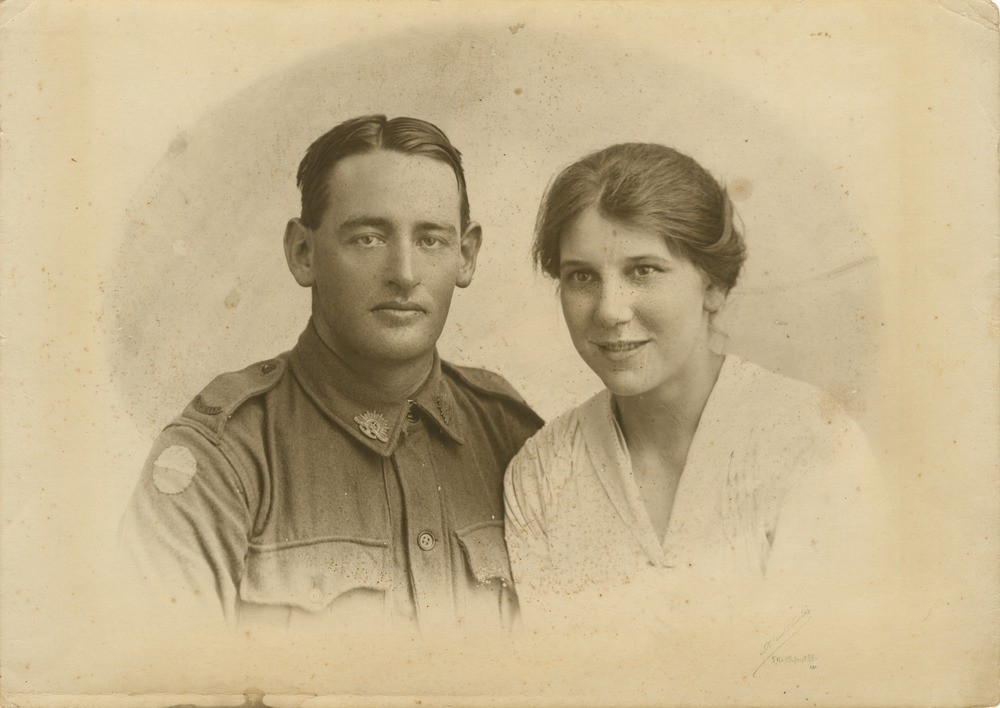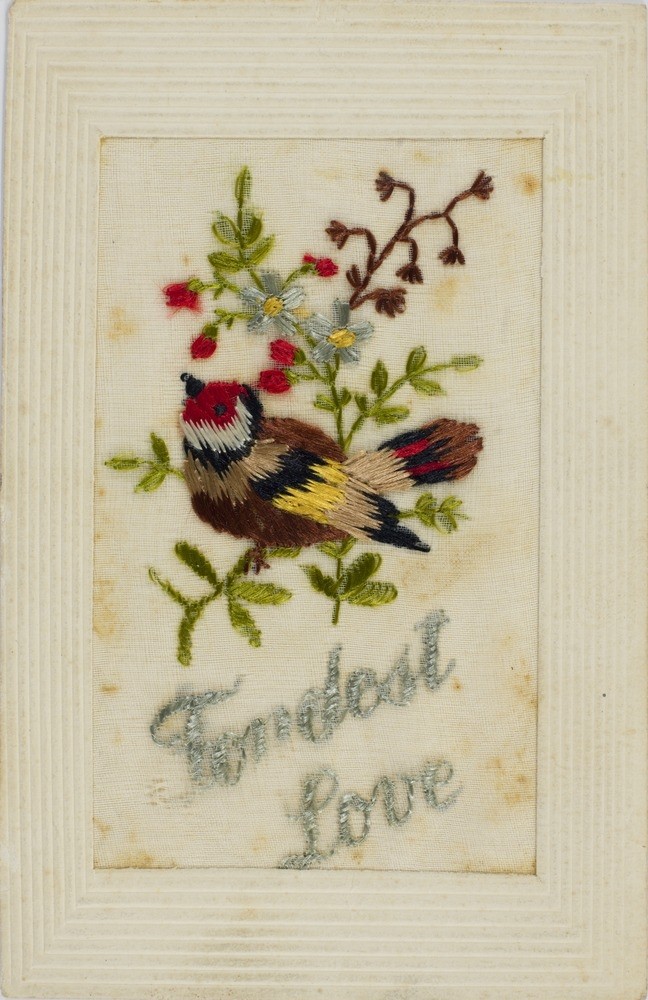
Private Frederick James (Jim) Bassett and his fiancée, Minnie Phipps, in London, England, ca. 1917. Source: John Oxley Library, Accession 30197/1.
A beautiful World War I collection which has recently been digitised is that of Frederic James Bassett of the 52nd Battalion. Much of the collection comprises postcards which Jim, as he was known, wrote to his cousin and fiancée, Minnie Phipps, whom he met in London during the war.
Jim Bassett (service no. 2621) was born in Dunbible, Northern New South Wales, in 1893. At some stage the family moved to Queensland. In 1916 Jim was working as a platelayer with the railways in Western Queensland and his family was located in Paddington, Brisbane. Jim enlisted at Emmett, near Blackall, 0n the 22nd May 1916. He had tried to enlist previously but had been rejected because he had a bad leg. Jim was assigned to the 52nd Battalion, 6th Reinforcements, travelling to Brisbane to train at Fraser's Paddock Army Camp at Enoggera.

New recruits, including Jim Bassett (circled in red) at Fraser's Paddock Army Camp, Enoggera, Brisbane, 1916. Source: John Oxley Library, Accession 30197/2.
Jim embarked from Sydney on the troopship "Ceramic" on the 7th October 1916, and after training in England, joined his battalion in France in December, during the bleak winter of 1916-17. The battalion alternated between front line duty and training behind the line. In early 1917 the 52nd joined the advance that followed the German retreat to the Hindenburg Line, participating in heavy fighting at Noreuil, France, on the 2nd April. Jim was injured in late April when he was caught in a barbed wire entanglement which badly damaged his right leg. In June 1917 he was invalided to England where he was posted to Verne Citadel at Portland, near Weymouth.

Private Frederic James Bassett. Source: John Oxley Library, Acc: 30197/3.
During this period Jim and Minnie were together as much as possible. Jim spent all his leave in London and Minnie would travel to Weymouth to spend time with him. The postcards reflect their growing love for one another. By August 1917 they were engaged and Jim was making plans for Minnie to travel to Australia where they planned to marry. On 16th August 1917 he wrote to Minnie:
I have not wrote & told Dad about you coming home with me yet. I will leave it & see if I get home on the next boat. You know, dear, one can talk better than he can write those things. Well Dear I think I will have to sign off for today & I will close with fondest love and heaps of kisses. From ever yours Jim xxx (item 28)
Shortly after on the 18th August Minnie wrote:
My darling boy. Just a card so that it shall arrive Monday morning. I have been thinking a lot of you this afternoon dear & wishing I was with you as I was last week this time. Fancy, we were away on the cliffs just you & I happy in one another's love. This week we are 100s of miles apart both very lonely but cheer up Dear we shall soon see one another again... Well dear I must ring off as you say, hoping your leg does not pain you & that your cold is better. Good night Darling. Always yours ever Minnie (item 29)

Postcard from Minnie to Jim, Acc: 30197/29.
Due to his injured leg Jim was declared medically unfit for duty and returned to Australia on the hospital ship A72 Beltana on 18th October 1917, leaving Minnie behind in London, but hoping that she would soon be able to join him. Their separation was longer and more difficult than either of them could have imagined due to the continuation of the war until November 1918, the priority of transporting troops back home to Australia and the Spanish influenza outbreak in 1919. Perhaps if the couple had married in England Minnie would have been given a greater priority as a war bride.
It was not until September/October 1919, two years since they had last seen each other, that Minnie was granted passage to Australia. Jim and Minnie were married on the 15th November 1919. Even then their separation was not at an end as Jim had to follow his work with the railways to the Bundaberg district while Minnie stayed behind with his mother and father (who were also her aunt and uncle) in Paddington, Brisbane. The postcards cover this later period of separation also. Eventually the couple were able to settle into their own home in Brisbane, living first at Albion, where Jim worked as a foreman, and in the mid 1930s moving to Riverview Street, Milton, where Jim is listed in the electoral rolls as working as a tramway employee. The 1950s found them in the pleasant seaside suburb of Redcliffe.
Sadly Jim suffered for the rest of his life from his injured leg. He never received a war pension for this injury and died in Greenslopes Repatriation Hospital in January 1974. Minnie died almost six years later in December 1979.
As well as correspondence the collection also includes a small pocket diary kept by Jim in 1917, several photographs, Minnie's British passport which enabled her to travel to Australia, and Jim's certificate of discharge from the AIF.
This lovely collection, which includes a vast array of French silk postcards, is available at the John Oxley Library (Accession 30197) and online.

French silk postcards from the Bassett Collection.
Want to Help?
One of the priorities of State Library is to ensure that its digital collections of diaries, correspondence and manuscripts are easily accessible to researchers, writers and anyone with an interest in the stories of Queensland. Transcribing our digital material makes it searchable and easier to read. You can participate by helping us transcribe the Frederic James Bassett collection in DigiVol, an online transcription platform hosted by Australian Museum in collaboration with the Atlas of Living Australia. To get started go to our DigiVol webpage and follow the links.
Lynn Meyers, QANZAC100 Content Curator
Comments
Your email address will not be published.
We welcome relevant, respectful comments.